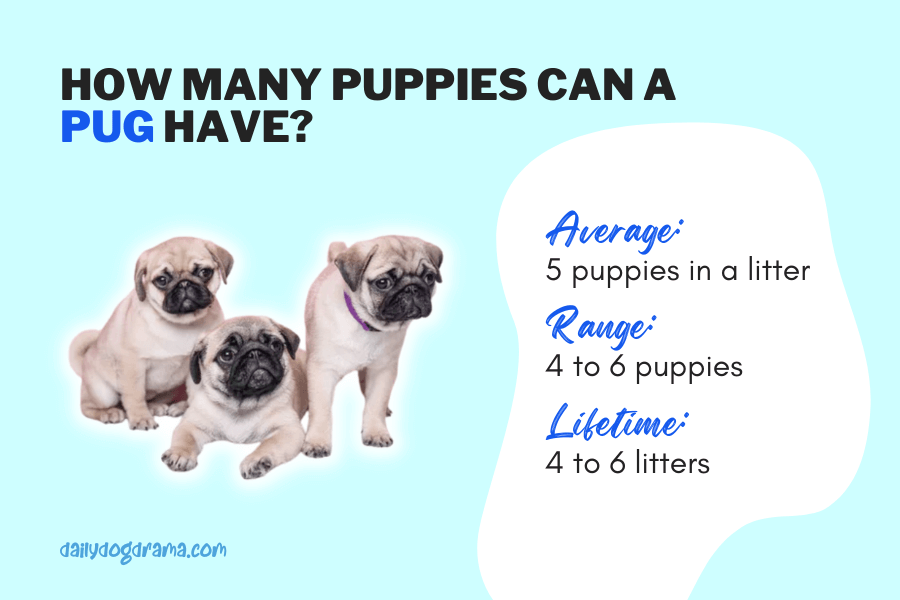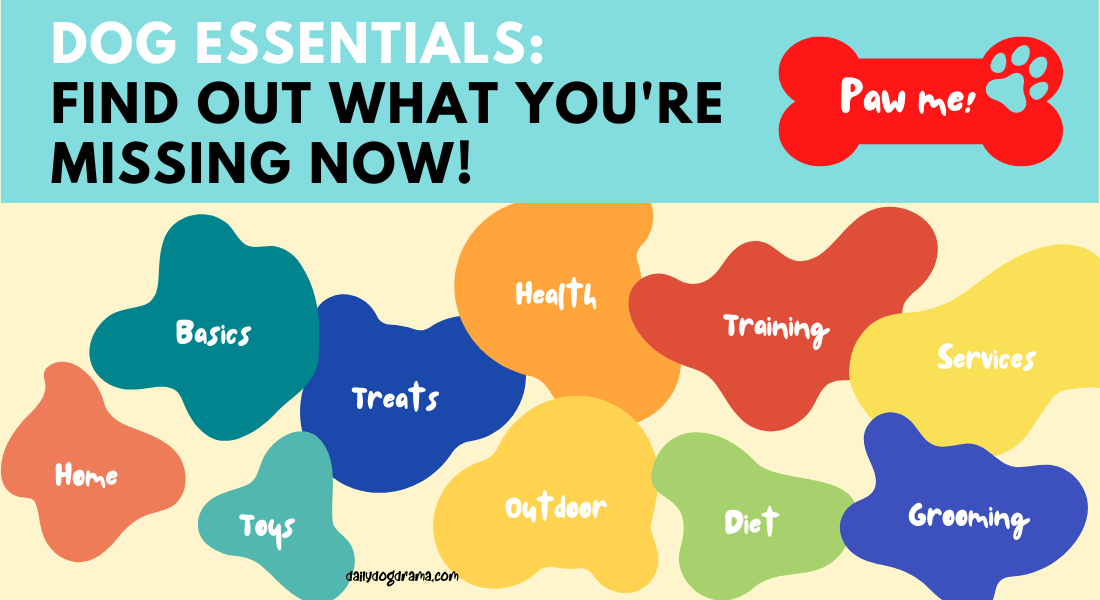Do you know what DOG ESSENTIALS you are missing out? Find out now!
Zack Keithy, our author, is a certified veterinarian technician (UC Blue Ash) for over 6 years (contact him here). The articles written here are based on his expertise and experience, combined with a review by our expert vet reviewers including Dr M. Tarantino. Learn more about us here.
Some people enjoy having their own puppies; they’re cute and fun to play with! But others are also interested in making some money off of breeding pugs, which is why this question often comes up:
How many puppies can a pug have?
Although the pug is a small breed dog, it has on average 4 to 6 puppies in one litter, a fair bit more than usual. In fact, this number can sometimes go up to 8, but this is considered unusual. Various factors such as age and health will influence this.
In this post, we shall look into the numbers a bit more in detail, talk about the factors that can influence litter sizes, and handling a Pug pregnancy.
Medical Questions? Talk to a Veterinarian 24/7.
Connect one-on-one with a licensed vet who will answer your questions in minutes.
*Article may contain affiliate links to retailers like Amazon and Chewy. Learn more on our disclosure page.

- Some Facts and Trivia About Pugs
- How Many Puppies Can a Pug Have in One Litter?
- How Big Is a Pug Puppy at Birth?
- How Many Healthy Litters Can a Pug Have in Their Lifetime?
- What Determines the Number of Pug Puppies in a Litter?
- At What Age Can You Breed a Pug?
- What Age Do Pugs Go in Heat?
- How Do You Know if Your Pug is in Heat?
- How Often Do Pugs Go Into Heat?
- How Long Does a Pug Stay in Heat?
- How to Tell if My Pug is Pregnant?
- How Long is a Pug Pregnant for?
- How Do I Know When My Pug is About to Give Birth?
- Care Tips for a Pregnant Pug
- Should You Breed a Pug?
- Frequently Asked Questions (FAQs)
- In Conclusion: How Many Puppies Can a Pug Have?
Some Facts and Trivia About Pugs
Pugs were kept as lapdogs by Chinese emperors, who provided them with all the comforts of royal life. These spoiled dogs occasionally received their very own little palaces and guards!
Their pushed-in noses are a familiar feature, but that also means they are brachycephalic. Although adorable, these compressed features often cause respiratory difficulties. Pugs may breathe noisily while rushing about because of their facial anatomy, which makes it difficult for them to breathe deeply and for lengthy periods of time.
Surprise! Contrary to what many people think, pugs are not related to bulldogs. About the only thing they have in common is that they are both wrinkled. It turns out that the Pekingese and pugs have the closest relations.
How Many Puppies Can a Pug Have in One Litter?
A Pug will have on average 5 puppies in a litter, and the range is usually between 3 and 6 puppies.
On very rare occasions, a Pug can give birth to up to 10 puppies in a litter, like this dam in Liverpool, England.
The size of the litter can be influenced by the breeding lines; some lines tend to have larger litters than others.
Pug owners who are considering breeding their dogs should talk to a veterinarian or breeder about the size of the anticipated litter.
Many other variables, which I go into more detail about in the sections below, will also affect how many puppies there are in a litter.
How Big Is a Pug Puppy at Birth?
At birth, a pug puppy weighs around 2.5 to 10 ounces (75 to 280 grams) only!
At this stage, the puppies are incredibly vulnerable to infections and other health problems, so it’s important to take them to a veterinarian as soon as possible for their first round of vaccinations and other treatments.
The breed standard for Pugs is between 14 and 18 pounds (6.35 to 8.16 kg) for adults, and the weight can vary slightly depending on genetics, its diet and activity level.
How Many Healthy Litters Can a Pug Have in Their Lifetime?
All dogs, including Pugs, do not go through menopause and are able to reproduce right up until the moment of their passing.
Their heat cycle typically lasts between 5 and 8 months or around twice a year.
However, just because they are capable of doing so does not imply that they should mate twice a year.
Pugs shouldn’t mate more than once a year and shouldn’t reproduce more than four to six times throughout their lives.
Your Pug will experience a lot of stress from overbreeding, which can result in a range of health issues like heart disease, arthritis, and infertility.
Also, stopping early is necessary in order for it to be spayed and to enjoy a happy life even after retirement.
Add to the fact that there are nations where it is illegal to breed a dog more than four to six times in its lifespan, and you should understand the importance of not overbreeding.
In the US, the American Kennel Club (AKC) does not accept registrations for dams that are bred over the age of 12 and under 8 months, and sires that are over the age of 12 and under 7 months.
What Determines the Number of Pug Puppies in a Litter?
In this section, we’ll discuss the key factors that determine the number of Pug puppies in a litter.
1. Age of the dam
Typically, as the dam ages, the size of the litter decreases.
Oddly enough, the first 2 litters are often smaller than the following ones, so once your Pug breeds again after the first two litters, you should likely see your dam having one or two extra puppies.
It’s also crucial to remember that breeding a dog after the age of seven or eight is not advised because it’s too late to have puppies and could result in health problems for both the mother and the puppies.
If at all possible, have your dog spayed long before then to improve its overall health.
2. Age of the sire
The father of your Pug’s litter will also have an impact on the litter size too, although less so than the mother.
Even if the female is exceptionally productive, there may be fewer puppies in each litter because a dog’s sperm quality begins to drop at the age of 5 to 6.
Occasionally, breeders have to rely on artificial insemination to aid in breeding older males, which is why it is better to only breed when they are younger.
3. Health of the mom
Only when the mother is healthy may a puppy be born healthy too.
Before a dog becomes pregnant, it’s crucial to pay close attention to both its emotional and physical health, making sure it receives plenty of affection, exercise, and mental stimulation.
Not only that, nutrition also has a significant impact on the number of puppies in a litter.
A high-quality, protein-rich diet should be consumed all year long in order to increase the likelihood of having a larger litter.
Dams with unhealthy diets, especially those who are overweight, tend to have smaller litters.
4. Size of dog
Bigger body sizes (in terms of build, not weight) are often associated with larger litter sizes within a particular breed.
Being a small breed, the Pug is not physically capable to have a big litter of puppies as compared to for example a Doberman.
Generally speaking, Pugs with larger frames may have slightly larger litter sizes, though this would only be a minor factor given how little difference there is between their sizes.
5. Litter in which mom was born
The level of fertility of your Pug has a thing or two to do with the litter it was born in.
If she was born into a large litter herself, she will likely have a larger first litter.
On the other side, you may generally anticipate that your girl will have a small first litter if she was born in a small litter herself.
6. Type of breeding
Actually, it might be better to save this topic for a later article given how easily it could become complicated.
But for now, just be aware that the method of reproduction can significantly affect both the number and caliber of puppies.
For instance, if inbreeding is overly extreme, a litter’s quality may suffer.
The health of the puppies will be impacted not only by reduced litter sizes but also by shorter lifespans and a greater likelihood of genetic diseases.
These problems are more likely to develop as the ties between the dogs get stronger.
Linebreeding, on the other hand, aims to maintain sufficient genetic diversity while preserving the best genes from a bloodline, making it frequently a safer method of dog breeding.
7. Time of breeding
It is said that a dam is more likely to have a larger litter size the closer she is to ovulation.
This is defined as the period after the estrogen period when the Luteinizing hormone triggers ovulation.
Unfortunately, I have not been able to find any studies supporting this theory, so at this point, I would say this factor is probably not that significant.
At What Age Can You Breed a Pug?
Although Pugs can begin reproducing once they reach their first heat cycle, it is not a good idea at all and must be avoided.
A Pug’s first heat cycle typically occurs between 6 and 9 months of age, which is way too early for them to start reproducing.
Wait until your dog is at least in her second or third heat cycle to give her enough time to develop sexually and gain weight and size.
Most ethical and responsible breeders will wait till a Pug is at least 2 years old before breeding them as they would have completed all the necessary medical checks by then.
What Age Do Pugs Go in Heat?
Most female Pugs go through their first heat cycle between the ages of 6 and 9 months.
If your girl hasn’t gone through her first heat cycle by the time she is 15 months old, speak with your veterinarian to rule out any underlying medical conditions.
A useful rule of thumb is that it will go into heat at about the same age that its mother did.
How Do You Know if Your Pug is in Heat?
Numerous symptoms, including bloody discharge, receptivity to male dogs, restless behavior, and others, can indicate that a dog is in heat.
Here’s a breakdown:
- Swollen vulva
- Discharge from the vulva
- Receptive to male dogs
- Change in appetite
- Excessive licking of the genital area
- Agitated, anxious, or aggressive behavior
- Urinating more frequently
- Holding its tail close to the body
How Often Do Pugs Go Into Heat?

A Pug will go into heat about once every 6 months, but this can vary depending on each individual dog.
Once your dog has experienced its first two 2 heat cycles, the period between them will be more consistent in time to come.
While some dogs’ cycles could be a little bit longer or shorter than others, you should be keeping track of when they happen.
Consult your veterinarian to determine whether there is anything that could be causing your dog’s variable seasons.
There is often more time between seasons as dogs get older (but can still get pregnant).
How Long Does a Pug Stay in Heat?
When we refer to a dog as being in heat, we typically mean that it is in the estrus stage of the heat cycle, which is when they actually see “action” with a male dog.
The entire cycle is as follows, and it is during the estrus period when a dog will show all the signs discussed above:
- Phase 1: Proestrus (~7 to 10 days)
- Phase 2: Estrus (~5 to 14 days)
- Phase 3: Diestrus (~10 to 140 days)
- Phase 4: Anestrus (~6 months)
How to Tell if My Pug is Pregnant?
Here are the most common signs that your Pug is pregnant:
- Nipples enlarged
- Increased hunger
- Irritability (may have a short temper)
- Decrease in activity and energy levels
- Behavioral changes
- Weight gain
- Starts nesting
- Seeks more attention
When you notice all of these happening, and about 25 days have passed since mating, you should bring your girl to the vet for an ultrasound or a blood test to determine if it’s pregnant.
Check out our dog pregnancy calendar to find out when your dog is due!
How Long is a Pug Pregnant for?

Dogs, no matter the breed, are usually pregnant for 56-64 days, or about 2 months.
There won’t be many, if any, obvious indicators of pregnancy in the first two weeks in your dog as the changes are currently taking place internally within the uterus.
However, your Pug will soon start to lose hair around the breasts, develop larger, darker nipples, and develop darker nipples at around 3 weeks of pregnancy.
How Do I Know When My Pug is About to Give Birth?
It is important to be aware that dogs usually give birth around 2 months (56 to 64 days) after getting pregnant so that you can prepare for it.
As the time draws nearer, there will be a number of telltale signs that your dog might be whelping soon.
- Spending more time in her “nest”
- Shivering
- Panting
- Straining
- Drop in body temperature
- Restlessness
- Vomiting
- Not eating much
- Digging and scratching
- Lethargy
- Start producing milk
Care Tips for a Pregnant Pug
There are a number of things you can do to ensure your dog has the best chance of giving birth to healthy puppies.
Maintaining your dog’s health and happiness throughout pregnancy will help them feel comfortable and ensure a pain-free delivery.
Here are a few tips:
Regular checkups
You need to schedule regular checkups with your vet, especially in the last 3 weeks of pregnancy, or if you notice any changes in your dog’s behavior.
This will help make sure that everything is going as it should be during pregnancy and birth.
Balanced diet
During pregnancy, your Pug really needs to have a balanced diet that is palatable and easily digestible.
This means that she should get plenty of protein (chicken is a good choice), and some fruits and vegetables for vitamins and minerals.
You can also supplement the diet with calcium tablets or other supplements if you want to be extra careful about making sure your dog gets everything she needs during this time.
Quiet environment
Pregnant dogs, especially those that are expecting their first litter, may get nervous if they are exposed to too much noise.
Your Pug should have a quiet environment in which she can relax.
Avoid taking her out to crowded areas (definitely no dog parks!), and keep her away from loud noises and other dogs that may be around.
If you have other pets in the house, make sure that they aren’t being too loud or active around your pregnant dog.
Activity
Even while pregnant dogs shouldn’t exercise vigorously, they can still gain from being given attention, gentle play, and frequent short walks.
It’s true that they shouldn’t be overstimulated, but you also shouldn’t allow her to become too passive because this can quickly result in health issues.
I would advise you to allow your dog up to two walks per day, lasting up to 15 minutes each, during this time.
During the last three weeks of pregnancy, a pregnant dog must be kept away from other dogs and animals; therefore, allow her to get some light exercise inside during this time rather than taking her outside.
Should You Breed a Pug?
This is a hotly debated subject among dog owners and experts alike.
If you are considering breeding a pug, you need to be aware of the many health and behavioral problems that can potentially occur.
These issues are often passed on from generation to generation, so it’s important that you do your research before deciding whether or not this is the right thing for you and your dog.
If you do decide to breed her, make sure the parents have no history of genetic diseases or medical conditions.
Short-nosed breeds like pugs can have significant respiratory distress, difficulty regulating their body temperature, an inability to close their eyelids, and other symptoms due to brachycephalic syndrome.
So, given that these animals will be bred indefinitely and that they will be born chronically unwell, is it really acceptable to keep doing so?
Not forgetting that most pug births require C-sections due to their large heads, which will be an added expense on top of many other costs.
Is that something you really want to go through?
Frequently Asked Questions (FAQs)
How many puppies can a pug have for the first time?
The first two litters are usually smaller, so a dog owner can expect to have around 3 or 4 puppies in their pug’s first birth. Usually, the number progresses to the average of 4 to 6 puppies in their third pregnancy.
Can a pug give birth naturally?
Yes, a pug can give birth naturally, but more often than not, they need to have a Caesarean due to a combination of a pug’s large head and narrow hips.
How many times can pugs get pregnant?
Dogs do not experience menopause, so they can theoretically give birth even in old age. However, it is recommended to only breed your Pug only once a year and stop by the time they are 7 years old.
Do pugs have difficult births?
Yes, most pugs will have difficult births. Due to their enormous heads, broad shoulders, and narrow pelvises, which result in the pups’ shoulders being too big to pass through their mother’s pelvic canal, they have a difficult time giving birth.
In Conclusion: How Many Puppies Can a Pug Have?
I’ve covered a lot of ground here, so perhaps you now have a better understanding of how big Pug litters are and the factors that affect them.
Consider adopting one from a shelter or rescue group if you’re unsure whether you should breed them.
They are numerous and in desperate need of our support, shelter, and love.
Click here for information on other dog breeds’ litter sizes.
You’ve made it to the end, but I hope it’s not the end of our journey. We want to hear your voice! Share your thoughts, problems, suggestions, or anything related to your dog in the comments section. And don’t forget to join our newsletter today too.





On May 12, 2023, our pug Daisy had her first litter. She gave birth to 9 girls, and 3 boys…12 pug puppies, all live! Immediately they were taken to the vet. He predicted that we would lose some of the pups. Unfortunately, true to his prediction, we have lost 4 of the pups, even with supplemental feeding and Daisy doing her best, rotating the pups, trying to keep them all fed. .
Oh my god! That must be the most pug puppies I have ever heard of! I hope you don’t feel too bad about the loss, as this tends to happen quite often. Pugs are not equipped to handle so many babies after all.. but I’m sure you will do excellent with your dog and the newborns! Would you be keeping them or finding them a new home? All the best to you no matter what!